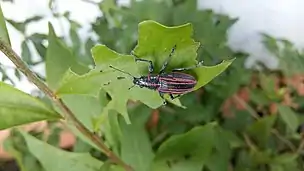Naupactini
Naupactini is a tribe of broad-nosed weevils (subfamily Entiminae). Primarily from the Neotropical realm, reaches highest genus and species diversity in South America. Their size varies from 3.5 to 35 mm long, and its colour patterns are diverse. As well many has colourful iridescent scales (bluish, greenish or golden), others show opaque scales or setae, and some are subglabrous. In habitats with sparse vegetation or trees absence, the occurrence of flightlessness and parthenogenesis is frequent.[1]
| Naupactini | |
|---|---|
_(14364800677).jpg.webp) | |
| Naupactus cervinus | |
| Scientific classification | |
| Kingdom: | |
| Phylum: | |
| Class: | |
| Order: | |
| Suborder: | |
| Infraorder: | |
| Superfamily: | |
| Family: | |
| Subfamily: | |
| Tribe: | Naupactini Gistel, 1848 |
| Genera | |
|
See text | |
Females of Naupactini usually lay their eggs between adjoining surfaces (e.g. in litter between fallen leaves, in cracks in the soil, and in crevices of tree trunks and calices of fruits), in batches covered by an adhesive substance (Marvaldi, 1999). Their ectophytic larvae live in soil where they feed externally on the roots of their host plants (Marvaldi et al., 2002, 2014; Oberprieler et al., 2014). Although naupactine weevils are capable of eating a large range of different foods, the majority of them show at least some preference for certain plant families, especially Fabaceae (Lanteri et al., 2002). Several species are considered agricultural pests in both their native ranges and places where they have been introduced due to human activities (Lanteri et al., 2013a).
Due to being agricultural pests in many crops[2] and being considered of major fitosanitary importance,[3] biological control with parasitic nematodes is being developed.[4][5]
Several studies links parthenogenesis and the presence of parasitoid bacteria Wolbachia. The parasite generates thelytokous parthenogenesis but also other reproductive alterations on the host, increasing its frequency on the population, as the main way of transmission is maternal [6]. Although, Wolbachia's horizontal transfer amongst unrelated invertebrates species is extensive.[7]

Genera
Acyphus – Alceis – Amitrus – Amphideritus – Aptolemus – Aramigus – Artipus – Asymmathetes – Asynonychus – Atrichonotus – Brachystylodes – Briarius – Chamaelops – Corecaulus – Curiades – Cyphoides – Cyphopsis – Cyrtomon – Enoplopactus – Ericydeus – Eurymetopus – Exophthalmida – Fascaevinus – Galapaganas – Glaphyrometopus – Hadropus – Hoplopactus – Ischnomias – Lamprocyphopsis – Lamprocyphus – Lanterius – Leschenius – Litostylodes – Litostylus – Macrostylus – Megalostylodes – Megalostylus – Melanocyphus – Mendozella – Mesagroicus – Mimographus – Mionarthrus – Moropactus – Myociphus – Naupactus – Neoericydeus – Obrieniolus – Pactorrhinus – Pantomorus – Parapantomorus – Parasynonychus – Parexophthalmus – Phacepholis – Platyomus – Plectrophoroides – Priocyphopsis – Priocyphus – Protonaupactus – Rhynchuchus – Saurops – Squamodontus – Stenocyphus – Teratopactus – Tetragonomus – Thoracocyphus – Trichaptus – Trichocyphus – Trichonaupactus – Wagneriella – ?†Arostropsis
According to Lanteri (2017), the genera Mimographus, Hoplopactus and Naupactus are not monophyletic, Artipus belongs to Geonemini tribe, and Mimographopsis and Floresianus should be resurrected as extant genera.[1]
References
- Lanteri, Analia A.; Rio, Maria G. Del (2017). "Phylogeny of the tribe Naupactini (Coleoptera: Curculionidae) based on morphological characters". Systematic Entomology. 42 (2): 429–447. doi:10.1111/syen.12223. ISSN 1365-3113.
- Parra, José R. P.; Guedes, Jerson C.; Lanteri, Analía A. (2002). "Weevils Injurious for Roots of Citrus in São Paulo State, Brazil". Neotropical Entomology. 31 (4): 561–569. doi:10.1590/S1519-566X2002000400008. ISSN 1519-566X.
- Argentina), Red Iberoaméricana de Biogeografía Entomología Sistemática. Reunión Anual (3rd : 2006 : La Plata (2008). Contribuciones taxonómicas en órdenes de insectos hiperdiversos : III Reunión Anual de la Red Iberoamericana de Biogeografía y Entomología Sistemática: La Plata, Argentina. Llorente-Bousquets, Jorge,, Lanteri, Analía Alicia,, Universidad Nacional Autónoma de México. Facultad de Ciencias. Prensas de Cincios,, Museo de La Plata., Universidad Nacional de La Plata. Facultad de Ciencias Naturales., CYTED (Organization) (1a edición ed.). Mexico, D. F. ISBN 9789703254170. OCLC 1038800932.
- Gulcu, Baris; Hodson, Amanda; Omaleki, Vinton; Ross, Andrew B.; Lewis, Edwin E. (2019-01-01). "A biological control approach to reducing Naupactus godmani (Curculionidae) populations in citrus using entomopathogenic nematodes". Crop Protection. 115: 99–103. doi:10.1016/j.cropro.2018.09.017. ISSN 0261-2194.
- Paola Luppichini B., Andrés France I., Irina Urtubia H., Natalia Olivares P. y Fernando Rodríguez A. (2013) Manejo del Burrito de la vid, Naupactus xanthographus (Germar) y otros curculiónidos asociados a vides. Boletín INIA Nº 260. ISSN 0717-4829.
- Rodriguero, M. S.; Confalonieri, V. A.; Guedes, J. V. C.; Lanteri, A. A. (2010). "Wolbachia infection in the tribe Naupactini (Coleoptera, Curculionidae): association between thelytokous parthenogenesis and infection status". Insect Molecular Biology. 19 (5): 631–640. doi:10.1111/j.1365-2583.2010.01018.x. ISSN 1365-2583. PMID 20597993.
- N., Hughes, R. (2002). Progress in asexual reproduction. John Wiley & Sons. ISBN 978-0471489689. OCLC 47232865.
- Gistel, J. 1848: Faunula monacensis cantharologica. (Fortsetzung). Isis von Oken, 1848(8): third unnumbered page in the Section Umschlag (front covers).
- Alonso-Zarazaga, M.A.; Lyal, C.H.C. 1999: A world catalogue of families and genera of Curculionoidea (Insecta: Coleoptera) (excepting Scolytidae and Platypodidae). Entomopraxis, Barcelona.